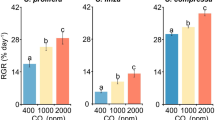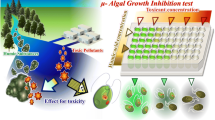Abstract
Background
and Aim. Humic substances (HS) comprise the majority of dead and living organic carbon, including organisms. In the environment, they are considered to be chemically inert or at least refractory. Recent papers, however, show that HS (including natural organic matter – NOM, isolated by reverse osmosis) are natural chemicals which interact with aquatic organisms. They are taken up and cause a variety of stress defense reactions which are well known from man-made chemicals. These reactions include chaperon activation, induction and modulation of biotransformation enzymes, or induction of antioxidant defense enzymes. One specific reaction with freshwater plants is the reduction of photosynthetic oxygen release. In this contribution, we compare the susceptibilities (cell yield) of two closely related coccal green algae, Monoraphidium convolutum and M. minutum, towards various NOM isolates.
Methods
Cultures of M. convolutum and M. minutum were obtained from the algal collection of the Leibniz Institute of Freshwater Ecology and Inland Fisheries, Berlin, and from the Culture Collection of Algae, Göttingen, and maintained in a common medium. The cultures were non-axenic. The algae were exposed to 5 mg L-1 DOC of each humic material, an environmentally realistic concentration. Cell numbers were counted microscopically in Neugebauer cuvettes in 5 replicates on days 1, 4, 7, 10, 14, and 21.
Results and Discussion
Almost all NOM isolates modulated the growth of the algae. Only the NOM of a Norwegian raised peat bog lake did not reveal any significant effect with M. convolutum. In general, the results with two algal species are by no means uniform. For instance, Suwannee River NOM causes a decrease in cell density with M. minutum, but temporarily stimulates the growth of M. convolutum. The opposite applies to Aurevann NOM: Growth increase in M. minutum, but a bi-phasic response in M. convolutum. Different responses of both Monoraphidium species must be attributed to intrinsic factors of the algae rather than only to chemical features of the exposed materials, because the exposures were identical with both algal species. The reduction in growth yields can be explained as a herbicide-like mode of action that affects the photosystem II most prevalently. The growth promoting effect remains somewhat obscure. It may be due to (1) an increase in bioavailability of some trace nutrients in the presence of HS, (2) the release of some growth promoting substances by microbial or photochemical processing of the humic materials, and (3) a hormetic effect upon the exposure of HS. Hormesis means stimulation of organisms or metabolic activities when exposed to noxes in low concentrations. However, it is still open to discussion why the growth promotion only applies to one or the other, but not simultaneously to both Monoraphidium species.
Conclusion
and Perspectives. Exposure of the closely related coccal green algal species to humic material changes their growth characteristics. Since the reactions are not consistent within the two species and the various humic materials, it seems that the less sensitive species is favored by HS exposure. The environmental relevance, however, is subject to future studies.
Similar content being viewed by others
Author information
Authors and Affiliations
Corresponding author
Rights and permissions
About this article
Cite this article
Steinberg, C. Natural Organic Matter Differently Modulates Growth of Two Closely Related Coccal Green Algal Species (6 pp). Env Sci Poll Res Int 14, 88–93 (2007). https://doi.org/10.1065/espr2006.06.317
Received:
Accepted:
Published:
Issue Date:
DOI: https://doi.org/10.1065/espr2006.06.317




